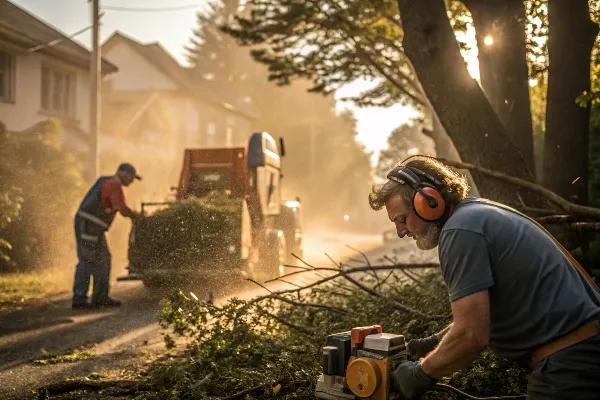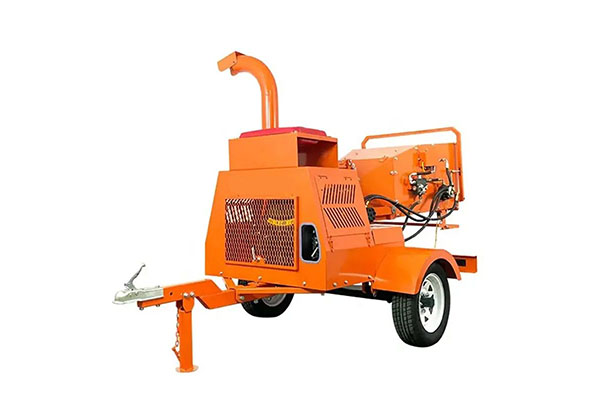Avoid your inquiry is delay response, please enter your WhatsApp/Skype along with the message, so we can contact you at the very first time.
We will reply you within 24 hours. If for urgent case, please add WhatsApp/WeChat: +8613791936882 ,. Or call +86-18678911083 directly.
I once struggled with frequent blade replacements. I wasted time and energy. I felt frustrated and stressed. I searched for a way out of this problem.
High-carbon steel and tungsten carbide are the best materials for wood chipper blades. High-carbon steel is affordable and simple to sharpen, while tungsten carbide is harder and lasts longer.
I want to explain why these materials help keep my chipper running smoothly. I also want to share tips for maintenance and replacement. Let’s explore each question in detail.
I remember ignoring blade maintenance. My machine vibrated more. My chips looked rough and uneven. I found myself spending extra money on fuel.
Yes, you do. Dull blades force the chipper to work harder and create uneven chips. Sharpening keeps the cut clean, protects the engine, and boosts overall performance.

sharpen wood chipper blade
I learned the hard way that neglecting blade sharpness can lead to big problems. Dull blades mean more stress on the engine and an increased risk of kickback. When I first started using a chipper, I only sharpened the blades after they became severely dull. That approach caused me to waste time and money on repairs. Now, I sharpen my blades more frequently, and I notice a huge difference in efficiency.
I discovered that my chipper performs best if I sharpen blades every 5–10 hours of use. This timing depends on the type of wood I process. Hard, knotty branches wear edges quickly, while soft pine is gentler. If I see chips becoming ragged or feel the machine laboring, I know it’s time for sharpening.
I keep my sharpening process simple. I might use a bench grinder for speed, but I remain careful not to overheat the steel. Excessive heat can ruin the blade’s temper.
• Hand file or whetstone: Good for minor touch-ups. Slow but precise.
• Bench grinder: Quicker, but I must cool the blades often.
• Professional service: Costs more, yet gives a polished, balanced result.
I also learned to keep the blades balanced. Uneven blades can create vibration and harm the chipper. That means I weigh each blade after sharpening and remove tiny amounts of metal until they match. Over time, I realized that this small step saves parts from early wear.
In my own experience, consistent sharpening is worth the effort. A well-sharpened blade handles hardwood better and produces uniform chips. It requires less engine power, too, which saves me money on fuel. I also like how clean cuts decompose more evenly in mulch applications. That makes my gardening projects simpler.
Below is a table that summarizes the pros and cons of different sharpening methods:
| Method | Pros | Cons |
|---|---|---|
| Hand file/whetstone | Low cost, gentle approach | Time-consuming, not ideal for heavy grinding |
| Bench grinder | Fast and precise if careful | Risk of overheating, requires skill |
| Professional service | Best accuracy and balance | More expensive, downtime if shipped out |
I rely on a combination of methods. Quick touch-ups happen with a file, but deeper restorations call for a grinder or specialist. Once I embraced sharpening as a routine, I noticed my chipper became safer, more reliable, and more fun to use.
I used to believe blades should last as long as possible before I replaced them. I ran them until they chipped and bent. Then I realized that waiting too long cost me more money.
Replace your chipper blades every 10–20 hours under heavy use. This varies with wood type, chipper model, and daily wear. Consistent checks help prevent bigger problems.
I learned that blade replacement is about prevention rather than reaction. If I keep running a blade until it’s too damaged, I risk harming my chipper’s rotor or housing. I also risk lower-quality chips. Let me share my thoughts on how I decide when to swap blades.
I watch for certain clues: unusual vibrations, reduced output, or ragged chips. Sometimes, I see burn marks on the wood, indicating excessive friction. I also examine the blade edges. If they are chipped or if the bevel looks chewed up, I act quickly.
I keep a log of my usage hours. Whenever I start a new project, I log the hours noted on the chipper’s meter. After each job, I update the total. That way, I never lose track of running time. If I find I have used the chipper for 15 hours on mostly hardwood, I inspect the blades. Even if they still look decent, I might change them if I have a critical job reminder.
Below is a quick chart explaining approximate replacement intervals for different materials:
| Blade Material | Typical Replacement Interval |
|---|---|
| High-Carbon Steel | Every 10–15 hours (hard use) |
| Tungsten Carbide | Every 20–30 hours (hard use) |
These figures are not strict rules. I adjust them based on personal observation. Good blade care can extend life, but eventually, metal fatigue sets in. Bent or cracked blades are never safe to reuse. I keep a spare set on hand to avoid downtime.
I also integrate my personal setup. I consider the time I spend, the roughness of the loads, and the importance of the final chips. Sometimes, a dull blade is okay if I’m just clearing a messy area. But if I want finely shredded mulch, I need sharp blades.
Replacing the blades at a sensible interval prevents damage and keeps my workflow efficient. I remember once ignoring replacement for too long. The rotor housing got scratched, and the repair bill was high. That incident taught me the importance of proactive blade changes.
When I first used my chipper on dense ash logs, my blades started to micro-chip along the edge. I realized that standard steel wasn’t the best choice for hardwood.
Tungsten carbide-tipped blades perform best on hardwood. They maintain hardness and resist abrasion, improving chip quality and lowering the risk of blade failure.

wood chipper blades for hardwood
Hardwood presents unique challenges. Dense fibers, embedded bark dirt, and possible knots put extra strain on blades. I recall one tough project with oak branches. My regular blades got dull quickly, and I spent too much time swapping them out. So I researched tungsten carbide. Once I tried them, I saw a difference in cutting performance right away.
Tungsten carbide is an alloy that holds an edge for a long time. It can handle the friction and impact of hardwood with fewer nicks. It also resists heat buildup better than standard steel. This matters because a blade that overheats can lose its temper and dull faster.
High-carbon steel, on the other hand, is cheaper and simpler to sharpen, but I find it less durable when faced with oak, walnut, or ash. I would sharpen those blades repeatedly, leading to downtime. Still, if budget is tight, high-carbon steel might suffice for periodic hardwood chipping.
Some chipper owners mix blade sets1, using high-carbon blades for light work and tungsten carbide blades for denser loads. That can cut costs while still offering high performance for the toughest tasks. I tried that method once. It helped me save the tungsten carbide blades for the most demanding jobs, preserving their sharpness.
Let me summarize the two main blade types:
| Blade Type | Pros | Cons |
|---|---|---|
| High-Carbon Steel | Cheaper, easy to sharpen | Dulls faster, may need frequent tuning |
| Tungsten Carbide | Longer-lasting, better for hardwood | Higher cost, requires specialized sharpening |
If I work with mostly hardwood, I prefer tungsten carbide because it reduces overall maintenance. I see fewer chips and cracks. I also save time on sharpening. Over the long run, that can offset the higher cost of these blades.
However, I understand that each person’s budget and workload differ. Some of my friends choose high-carbon steel2 and just sharpen frequently. Others buy two sets of carbide blades and rotate them to avoid downtime.
I also pay attention to how I feed the chipper. Even the best blade can fail if I overload the machine or toss in questionable debris. Small rocks and gritty bark can damage edges. Gentle feeding and smart sorting help keep my blades in top shape.
From my experience, tungsten carbide3 is the choice for demanding environments or commercial jobs. If I only chip softwood occasionally, high-carbon steel can be a reasonable alternative. It’s all about balancing cost, comfort, and chipping speed.
I keep my chipper strong by using quality blade materials, careful sharpening, and steady replacements. This helps me manage my tasks without frustration.